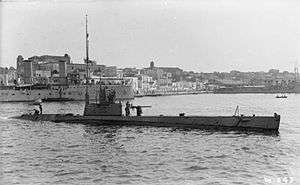HMS H8
HMS H8 was a British H-class submarine built by the Canadian Vickers Co., Montreal. She was laid down on 19 May 1915 and commissioned in June 1915. Like other Canadian-built submarines, she was sailed across the Atlantic for service in the North Sea and as recognition of this she initially remained under the command of her Canadian captain, Lieutenant-Commander B. L. Johnson, R.N.R. with a largely reserve crew. HMS H8 was sold on 29 November 1921 in Arbroath.
 HMS H4, another submarine of the same class | |
| History | |
|---|---|
| Name: | HMS H8 |
| Builder: | Canadian Vickers, Montreal |
| Laid down: | 19 May 1915 |
| Commissioned: | June 1915 |
| Fate: | Sold, 29 November 1921 |
| General characteristics | |
| Class and type: | H class submarine |
| Displacement: |
|
| Length: | 150 ft 3 in (45.80 m) |
| Beam: | 15 ft 4 in (4.67 m) |
| Propulsion: |
|
| Speed: |
|
| Range: |
|
| Complement: | 22 |
| Armament: |
|
Design
Like all pre-H11 British H-class submarines, H8 had a displacement of 364 tonnes (401 short tons) at the surface and 434 tonnes (478 short tons) while submerged.[1] It had a total length of 171 feet (52 m),[2] a beam length of 15 feet 4 inches (4.67 m), and a draught length of 12 feet (3.7 m).[3] It contained a diesel engines providing a total power of 480 horsepower (360 kW) and two electric motors each providing 320 horsepower (240 kW) power.[3] The use of its electric motors made the submarine travel at 11 knots (20 km/h; 13 mph). It would normally carry 16.4 tonnes (18.1 short tons) of fuel and had a maximum capacity of 18 tonnes (20 short tons).[4]
The submarine had a maximum surface speed of 13 knots (24 km/h; 15 mph) and a submerged speed of 11 knots (20 km/h; 13 mph). British H-class submarines had ranges of 1,600 nautical miles (3,000 km; 1,800 mi) at speeds of 10 knots (19 km/h; 12 mph).[1] H8 was fitted with a 6 pounds (2.7 kg) Hotchkiss quick-firing gun (6-pounder) and four 18 inches (460 mm) torpedo tubes. Its torpedo tubes were fitted to the bows and the submarine was loaded with eight 18 inches (460 mm) torpedoes.[1] It is a Holland 602 type submarine but was designed to meet Royal Navy specifications. Its complement was twenty-two crew members.[1]
References
- "H-class". Battleships-Cruisers, Cranston Fine Arts. Retrieved 20 August 2015.
- Derek Walters (2004). The History of the British 'U' Class Submarine. Casemate Publishers. pp. 2–. ISBN 978-1-84415-131-8.
- Colledge, J. J.; Warlow, Ben (2006) [1969]. Ships of the Royal Navy: The Complete Record of all Fighting Ships of the Royal Navy (Rev. ed.). London: Chatham Publishing. ISBN 978-1-86176-281-8. Retrieved from Naval-History on 20 August 2015.
- J. D. Perkins (1999). "Building History and Technical Details for Canadian CC-Boats and the Original H-CLASS". Electric Boat Company Holland Patent Submarines. Retrieved 20 August 2015.
Bibliography
- Robert Hutchinson. Submarines, War Beneath The Waves, From 1776 To The Present Day.
- William Guy Carr. By Guess and by God.